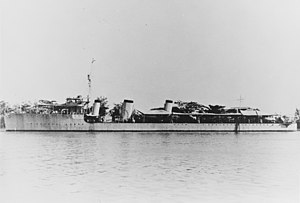 HTMS Phra Ruang at Bangkok on 29 November 1955 | |
| History | |
|---|---|
| Name | Radiant |
| Ordered | July 1915 |
| Builder | Thornycroft |
| Launched | 25 November 1916 |
| Commissioned | February 1917 |
| Fate | Sold on 21 June 1920 |
| Badge |  |
| Name | Phra Ruang |
| Namesake | Phra Ruang |
| Acquired | September 1920 |
| Decommissioned | 1957 |
| Stricken | 1959 |
| General characteristics | |
| Type | R-class destroyer |
| Displacement | |
| Length | 276 ft (84.1 m) |
| Beam | 26 ft 9 in (8.15 m) |
| Draught | 9 ft 10 in (3.00 m) |
| Installed power |
|
| Propulsion |
|
| Speed | 36 knots (67 km/h; 41 mph) |
| Range | 3,440 nmi (6,370 km) at 15 kn (28 km/h) |
| Complement | 82 |
| Armament |
|
HMS Radiant was an R-class destroyer which fought in the First World War as part of the Royal Navy before being transferred to the Royal Thai Navy, in which she served until well after the Second World War. [1]